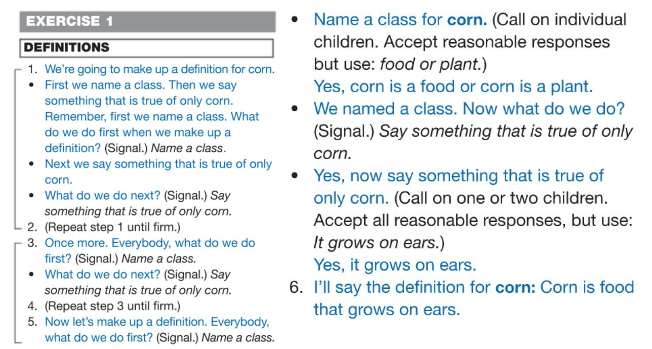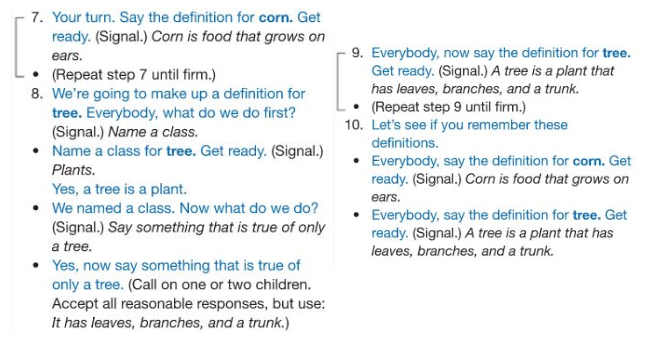Back to Course
Teach Reading Mastery Signature Edition: Language Arts: Year 1 and 2
0% Complete
0/0 Steps
-
Module Introduction5 Topics
-
Overview18 Topics|1 Test
-
Cover
-
Lesson Objective
-
Opening the lesson
-
Direct Instruction overview
-
Who it’s for
-
RMSE-LA 1 materials
-
RMSE-LA 2 materials
-
Time requirements
-
Placement test overview
-
Placement test guidelines
-
RMSE-LA 1 placement test specifics
-
RMSE-LA 2 placement test
-
Grouping and seating
-
Teacher’s guides
-
Script features
-
Check your understanding
-
Review
-
Lesson Completed!
-
Cover
-
Language Concepts21 Topics|1 Test
-
Cover
-
Lesson Objective
-
Opening the lesson
-
Actions exercises
-
Language concepts tracks in RMSE-LA
-
Corrections in actions exercises
-
Classification exercises
-
Corrections in classification exercises
-
Word skills exercises
-
Word skills (Opposites Exercises)
-
Word skills (Definitions Exercises)
-
Corrections in definitions exercises
-
Word skills (Synonyms and Contractions Exercises)
-
Sentence skills (Where, Who, When, What, Why and Questioning Exercises)
-
Verb tense and statements exercises
-
Reasoning skills
-
Script success
-
Check your understanding
-
Review
-
Review
-
Lesson Completed!
-
Cover
-
Pre-writing Skills21 Topics|1 Test
-
Cover
-
Lesson Objective
-
Opening the lesson
-
Introduction to RMSE-LA 2 (Part One)
-
Pacing introduction in RMSE-LA 2
-
Active monitoring procedure
-
Active monitoring
-
Auditory signal
-
Auditory signal
-
Classification and clues formats
-
Corrections in classification and clues
-
Temporal sequencing
-
Corrections in temporal sequencing
-
Pause and punch
-
Deductions
-
Dialect exercises
-
Directions exercises
-
Corrections in deductions and dialect and directions
-
Check your understanding
-
Review
-
Lesson Completed!
-
Cover
-
Story Grammar and Literature17 Topics|1 Test
-
Cover
-
Lesson Objective
-
Opening the lesson
-
Story grammar and literature in RMSE-LA 1
-
Presenting stories in RMSE-LA 1
-
Story introduction and details exercises in RMSE-LA 1
-
Extending story grammar in RMSE-LA 1
-
Sequencing and retelling stories in RMSE-LA 1
-
Firming student responses
-
Character identification in RMSE-LA 1
-
Story completion and plays in RMSE-LA 1
-
Story grammar in RMSE-LA 2
-
Cooperative activities in RMSE-LA 2
-
Expanded activities in RMSE-LA 2
-
Check your understanding
-
Review
-
Lesson Completed!
-
Cover
-
Beginning Writing Skills in RMSE-LA 2 (Part 1)15 Topics|1 Test
-
Cover
-
Lesson Objective
-
Opening the lesson
-
RMSE-LA 1 story-related sentence writing
-
Auditory signal
-
Auditory signal
-
RMSE-LA 1 teaching story-related sentence writing
-
RMSE-LA 1 cooperative story writing
-
RMSE-LA 1 main idea sentence writing
-
RMSE-LA 1 sequence sentence writing
-
RMSE-LA 2 parallel sentences
-
RMSE-LA 2 sentence construction
-
Check your understanding
-
Review
-
Lesson Completed!
-
Cover
-
Beginning Writing Skills in RMSE-LA 2 (Part 2)16 Topics|1 Test
-
Cover
-
Lesson Objective
-
Opening the lesson
-
Composing simple stories
-
Teaching composing simple stories
-
Reporting
-
Sentence writing reporting main idea
-
Clarity
-
Correcting ambiguous referents
-
Interpreting ambiguous sentences
-
Letter writing
-
Corrections
-
Script success
-
Check your understanding
-
Review
-
Lesson Completed!
-
Cover
-
Sentence Analysis in RMSE-LA 215 Topics|1 Test
-
Advanced Writing Skills21 Topics|1 Test
-
Cover
-
Lesson Objective
-
Opening the lesson
-
Editing
-
Auditory signal
-
Auditory signal
-
Main idea
-
Composing main idea sentences
-
Check boxes
-
Teaching tips for check boxes
-
The tick
-
Positive praise
-
Paragraph writing
-
Advanced paragraph writing
-
Writing with clarity
-
Specific praise
-
Student engagement
-
Correcting and firming writing
-
Check your understanding
-
Review
-
Lesson Completed!
-
Cover
-
Mastery Tests23 Topics|1 Test
-
Cover
-
Lesson Objective
-
Opening the lesson
-
Mastery tests RMSE LA 1-2
-
Conducting Mastery Tests
-
Scoring the test
-
Using Mastery Test information
-
Mastery Test criterion
-
Providing test temedies
-
Determining who needs remediation and retesting
-
Mastery Tests on SPT
-
Inputting data on SPT
-
Flight-path concept
-
Expected lesson pacing
-
Lesson progress on SPT
-
Pacing of instruction
-
Pacing of instruction
-
Effective transitions
-
Teaching routines
-
Effective routines
-
Check your understanding
-
Review
-
Lesson Completed!
-
Cover
-
Workbooks and Motivating Students22 Topics|1 Test
-
Cover
-
Opening the lesson
-
Lesson Objective
-
RMSE-LA 1 worksheets
-
The tick
-
RMSE-LA 1 classification
-
RMSE-LA 1 analogies
-
RMSE-LA 1 writing opposites
-
RMSE-LA 2 marking papers
-
Teacher’s role in motivation
-
Affirmations
-
STAR rules
-
Teacher-student game
-
Teacher-student game points
-
Points in the teacher-student game
-
Benefits of perky pace
-
Positive praise
-
Positive praise
-
Specific praise
-
Check your understanding
-
Review
-
Lesson Completed!
-
Cover
-
Bringing it All Together for RMSE-LA 119 Topics|1 Test
-
Cover
-
Lesson Objective
-
Opening the lesson
-
Teaching a complete lesson
-
Hand-drop signal
-
Hand drop signal
-
Lesson 53, exercise 1
-
Corrections
-
Lesson 53, exercise 2
-
Lesson 53, exercise 3
-
Lesson 53, exercise 4
-
Lesson 53, exercise 5
-
Lesson 53, exercise 6
-
Lesson 53, exercise 7
-
The tick
-
Lesson 53, exercise 8
-
Check your understanding
-
Review
-
Lesson Completed!
-
Cover
-
Bringing it All Together for RMSE-LA 215 Topics|1 Test
-
Module evaluation survey1 Topic
Participants 583
Lesson 3,
Topic 11
In Progress
Word skills (Definitions Exercises)
ddewell@goodtogreatschools.org.au August 7, 2023
Lesson Progress
0% Complete

Word Skills (Definitions Exercises)
‘Definitions’ exercises provide students with practice in constructing definitions.
These exercises start in lesson forty-one. Students learn that definitions provide word meanings. They learn a two-step operation consisting of identifying a class for the word being defined then telling something about the word that is only true of that object.


| The Process |
- Say; “We’re going to make up a definition for corn. First, we name a class. Then we say something that is true of only corn. Remember, first we name a class. What do we do first when we make up a definition?” and signal (hand-drop).
- Say; “Next we say something that is true of only corn. What do we do next?” and signal (hand-drop).
- Say; “Once more. Everybody what do we do first?” and signal (hand-drop). Ask; “What do we do next?’ and signal (hand-drop).
- Say; “Now let’s make up a definition. Everybody, what do we do first?” and signal (hand-drop).
- Say; “Name a class for corn” and call on individual students.
- Say; “Yes, corn is a food (or corn is a plant). We named a class. Now what do we do?” and signal (hand-drop).
- Say; “Yes, now say something that is true of only corn” and call on one or two students. Accept all reasonable responses but use ‘It grows on ears'”.
- Say; “Yes, it grows on ears. I’ll say the definition for corn: Corn is food that grows on ears. Your turn. Say the definition for corn. Get ready” and signal (hand-drop). Repeat until firm.
- Repeat the process for ‘tree’.
- Review the definitions for ‘corn’ and ‘tree’.
Turn to page 27 in ‘RMSE-LA 1’ Teacher’s Guide. Practice lesson 41, exercise 1 with your partner with no student-errors.

